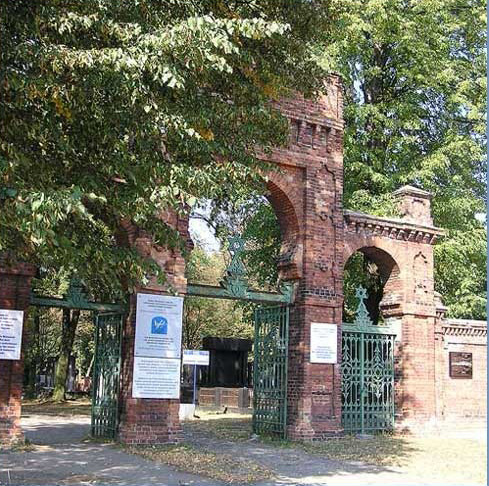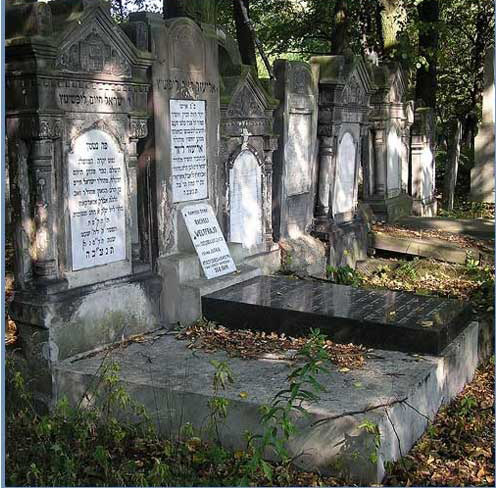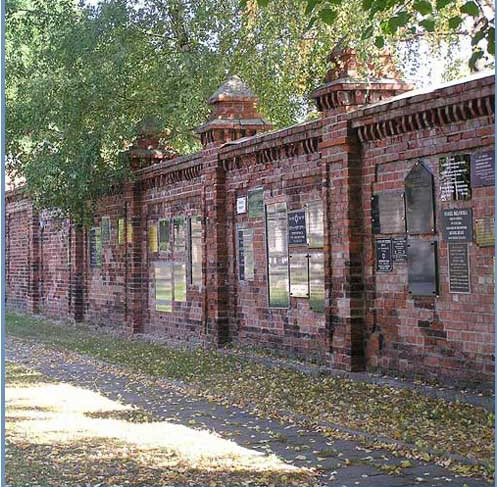
Project number: [JOWBR, POL-03068]
____________________________
The LÓDZ New Cemetery in LÓDZ, POLAND
Lodz Jewish Cemetery Records
Cemetery Description
by Roni Seibel Liebowitz

Early History
This New Jewish Cemetery, the largest Jewish Cemetery in Europe was established in 1892 on Bracka Street with the entrance on Zmienna Street, and contains more than 180,000 graves and 65,000 tombstones, ohels and mausoleums. It was created when residents of the nearby neighborhood refused to allow the expansion of the old cemetery on Wesola Street which was established in 1811 and served the community for 80 years. Destruction of the old cemetery began during the Nazi period but survived the war despite some headstones taken to be used as pavements for roads. Toward the end of the 1960s, Zachodnia Street was further developed, a process which completely destroyed the Old Jewish Cemetery. Today a commemorative headstone is located in a small square at 11 Rybna Street marking the grounds.
The outbreak of a cholera epidemic in 1892 forced the Russian authorities to give the final go ahead to establish the new cemetery. Izrael Poznanski donated the first 10.5 hectares of land towards its establishment. Thus, the first people to be buried there in the winter of 1892 were approximately 700 cholera victims. By 1893, 1,139 people were buried at this new cemetery. From 1893 to 1896, the basic construction of the cemetery was completed under the supervision of well-known architect Adolf Zeligson.
In 1896, some breaks from Jewish tradition were evident at the cemetery. Prior to this time, tradition dictated older tombstones face east towards Jerusalem. Now many were facing south or west. Great monuments and mausoleums replaced the customary headstone. Until then, men and women had their own burial quarters, now a woman might be buried next to a man.
World War II
During German occupation in 1939, the cemetery became part of the eastern section of the enclosed ghetto and became referred to as the “Cemetery at Marysin.” A total of about 200,000 Jews were incarcerated in the ghetto. Between 1940 and 1944, approximately 43,000 burials took place in the spare part of the cemetery that became known as the Pole Gettowe or Ghetto Field. The cemetery was the site of many mass executions of Jews, Roma (Gypsies) and non-Jewish Poles. Stone grave markers were forbidden so burial sites were marked by metal bed frames or low cement posts. According to the Jewish community archives, an estimated 45,000 victims were buried in this Ghetto Field during the years 1940-44. Not all those who perished in the ghetto were buried in there. Many people buried relatives in cemetery alleys and near their family graves.
Post-War
A large part of the cemetery was destroyed during the Communist Poland. In the early 1970's, a part of the cemetery's western wall was pulled down. Easy access led to theft and vandalism. An overgrowth of shrubs and plants now covered much of the landscape and contributed to more decay and damage.
In 1980, the Jewish Cemetery in Lodz was proclaimed a historical site. In 1995, the city of Lodz and the Organization of Former Residents of Lodz in Israel established the Monumentum Iudaicum Lodzense Foundation to preserve the heritage of Jewish Lodz and the cemetery in particular. Since then renovations and maintenance projects have been implemented and supported.
The Lodz Cemetery Database, a joint project of Jewish Records Indexing – Poland and JewishGen
While Jewish Records Indexing – Poland laid the groundwork for this project in 2009, the project became a joint effort of both JRI-Poland and JewishGen and for the convenience of researchers, the data appears in both the JRI-Poland database and the JewishGen Online Worldwide Burial Registry (JOWBR).
The JRI-Poland/JewishGen database was created with the cooperation of the Organization of Former Residents of Lodz in Israel (Tel Aviv). A volunteer photographed the 2,975 pages of the index to burials made from the original burial cards and lists.
This index contains most but not all burials. In addition, it should be noted that many of the matzetvot recorded in the burial cards no longer exist.
 Sample Index Page |
 Sample Burial Card |
Under the leadership of JewishGen's JOWBR Coordinator Nolan Altman, an international group of volunteers created the database. Currently there are 12,178 entries online of an estimated 75,000 burials. More will be added as they become available. Since data entry continues, if you are interested in assisting in data entry or proofreading, please contact Nolan Altman at NAltman@JewishGen.org
We wish to thank the volunteers whose work is making these records available; Alessandro Caprotti, Andy Anderton, Betty Black, Christine Elbert, Diane Perry, Harry Green, Hervé Kartaux, Joan Maplesden, Jolie Weininger, Marilyn Shalks, Maurice Kessler, Natasha Likholatnikova, Pedro Máximo de Macedo, Sharon Brearey, Sue Brady and Sue Goldberger.
Following up on a successful search of indices of graves at the Lodz Jewish Cemetery
JRI-Poland and JewishGen have no additional details or photographs associated with these burial records. "For further information, see the cemetery website. http://www.jewishlodzcemetery.org/defaultEN.asp
Sources and Additional resources
Books:
- Lodz Ghetto, A History, Isaiah Trunk, translated by Robert Moses Shapiro, USHMM and the Indiana University Press, 2006
- Cmentarz Zydowski w Lodz/ The Jewish Cemetery in Lodz by Bronislaw Podgarbi: (written in Polish and English) , Wydawnictwo Artus, 1990
- Przewodnik Po Cmentarzu Zydowskim w Lodzi /A Guide to the Jewish Cemetery in Lodz by Joanna Podolska and Jacek Walicki, Officyna Bibliofilow (written in Polish and English)
- Traces of the Litzmannstadt-Getto, A Guide to the Past by Joanna Podolska Piatek Trzynastego Wydawnictwo
- Jewish Cemetery of Lodz / Zydowski cementarz w Lodz by Andrzej S. Stanislawski (written in Polish and English). Many photographs are included
- The Missing District, People and Places of Jewish Lodz by Pawel Spodenklewicz
- Szkice z dziejow Gminy Zydowskiej oraz cmentarza w Lodz by Isaak Kersz (written in Polish, some English) Many photographs included.
Websites:
|





